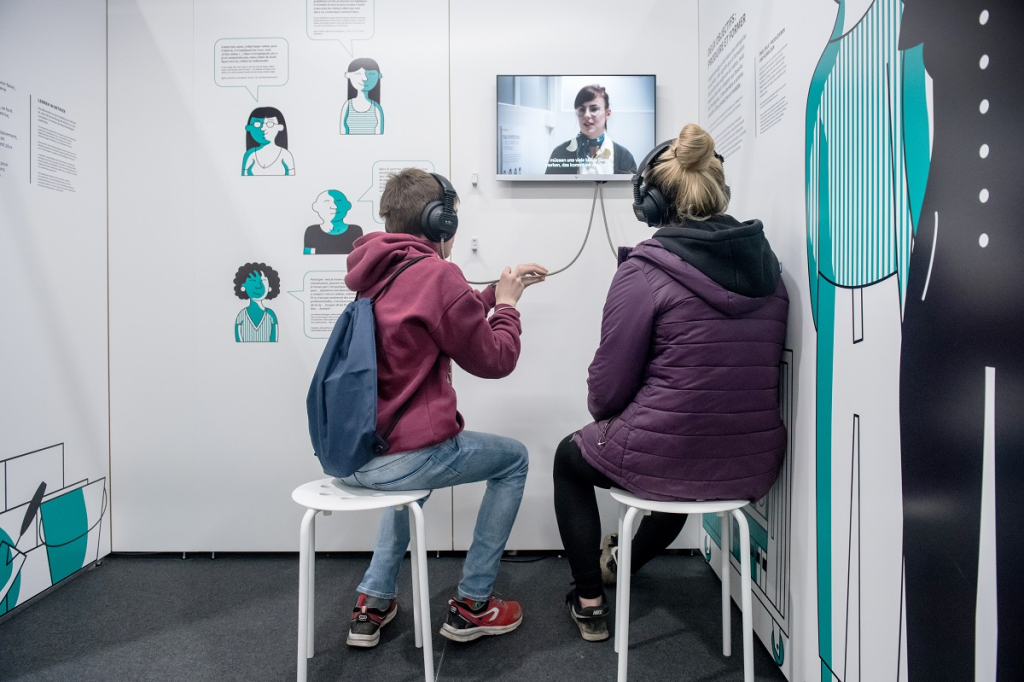At the heart of apprenticeships: a large public experiences company-based vocational training
Public information project funded by SNSF Agora. Thanks to an interactive exhibition presented at various professional trade fairs in the French-speaking part of Switzerland, a full dual apprenticeship cycle can be followed, from initial recruitment through to obtaining the diploma. The exhibition focuses on the relationship between trainers and apprentices in the company.
Based on the results and conclusions of a research project funded by the Swiss National Science Foundation (SNSF no. 100017_153323) about workplace trainers, the proposed communication project provides insight into dual-track vocational education and training (VET), which is the most frequently chosen upper-secondary level pathway in Switzerland. The focus is on the two main parties involved in dual-track VET programmes: apprentices and workplace trainers. Particular emphasis is placed on the relationship dynamics between the two, which plays a key role in the learning and socialisation processes of apprentices. The research project focused on the pivotal, yet largely ignored, role of workplace trainers and, so, investigated three sets of research questions: who trains apprentices in host companies; what motivates these people to become workplace trainers; and what were their former career paths? What is their daily routine in the company; what specific constraints do they face; and how do they deal with these constraints during workplace training? What role to workplace trainers play in the hiring process and as socialisation agents over the course of apprenticeship training?
Based on the findings of the research project and previous research (Duc & Lamamra, 2018; Lamamra & Masdonati, 2009), this interactive exhibition enables visitors to
- learn about the workplace training portion of dual VET through roleplay, creating an opportunity for hands-on exposure to the typical situations encountered by apprentices and workplace trainers,
- gain deeper insight into the daily routine of workplace training as well as associated challenges and achievements (i.e. the subjective opinions expressed by the aforementioned apprentices and workplace trainers) and
- show how scientific research can not only shed light on certain phenomena but also to influence them. To show the daily realities of workplace training, the project team chose the exhibit format as a means of communication
To illustrate the daily life of apprenticeship training in a company, the project results and conclusions will be communicated via an exhibition based on a training cycle (from the day an apprentice is hired to the day he or she enters professional life). This exhibition will be shown at job fairs (salons des métiers et de la formation) in French-speaking cantons.
The exhibition will target three groups:
- pupils at lower-secondary school (12–15 years old, i.e., potential future apprentices),
- their parents and
- their teachers. The member of the project team will be present to provide visitors with additional information
The researchers will also be present during the exhibition for further discussion with visitors. A web platform will be set up to offer visitors the opportunity to access additional content. This platform and its more detailed content and teaching materials will also be used by teachers to prepare their visit with their pupils or to pursue the discussion on core issues of dual VET after their visit. It will also be possible to download the exhibition’s videos from this platform. It will also provide a place for dialogue between researchers and the public.
Finally, the project team will carry out a double evaluation:
- a quantitative evaluation (number of visitors) and
- a qualitative evaluation conducted both during and after the exhibition.
This communication project is relevant for several reasons. First of all, In this manner the project will offer a large public the opportunity to experience and gain insight into the dual VET system. Observing a complete cycle will shed light on the relationship and interactions between apprentices and their workplace trainers; second, it will offer an inside perspective on some of the main issues of this educational route; third, it will show how science provides material for debating these core issues; and fourth, it will provide information on current political debates, offering different perspectives on a system that is appealing both in Switzerland and in countries abroad.
Interactive exhibition and website to present extended content.
